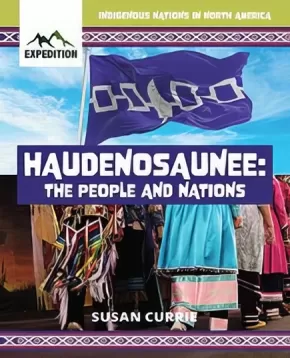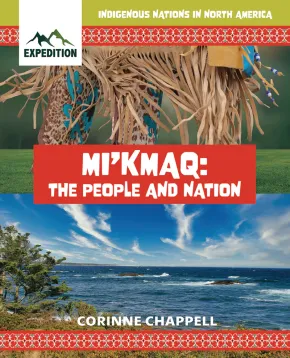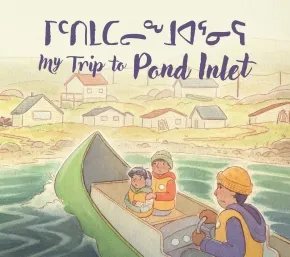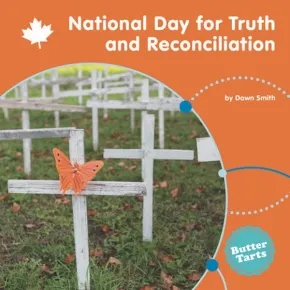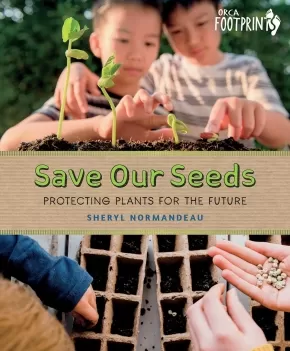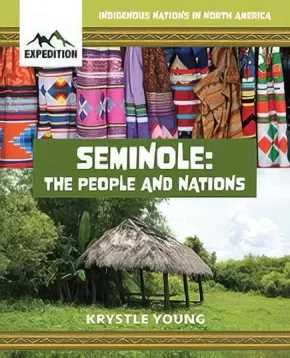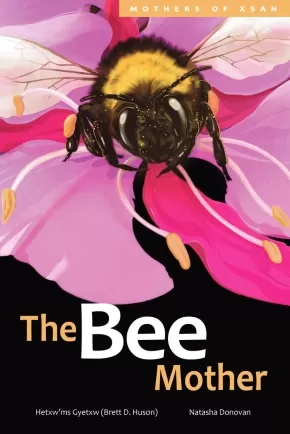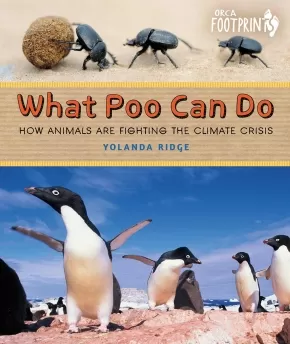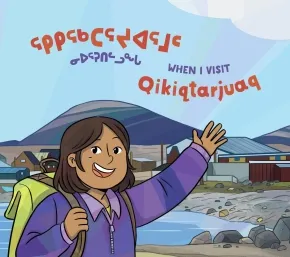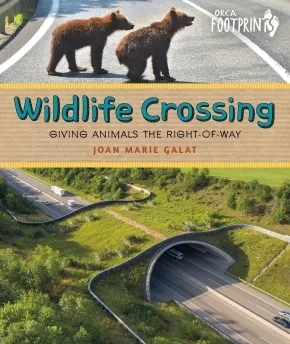
Series
31
-
45
of
406 Results;
Sort By
Go To
of 28
Get Outside!: How Humans Connect with Nature
$21.95
Format:
Hardcover
ISBN / Barcode: 9781459836877
Synopsis:
Synopsis:
We know spending time in nature is good for us, but why? And how did people become so disconnected from the natural world, anyway?
Get Outside! How Humans Connect with Nature explores the important relationship between people and nature. It asks big questions, like Are humans part of nature or separate from it? and Do all people have equal access to nature? By discussing global issues such as the climate crisis and environmental racism, the book shows us that, by strengthening our relationship with the natural world, we can learn how to take care of the environment and to let the environment take care of us too.
Reviews
“Payne argues that humans are part of nature and should be engaging with the natural world more often and more effectively…Informative and likely to spur readers to forge a stronger bond with the natural world.”— Kirkus Reviews
“The text is visually striking…This book should appeal to readers interested in or curious about the outdoors and could lead to deeper engagement or activism.”— School Library Journal (SLJ)
Educator & Series Information
Recommended for ages 9 to 12.
This book is part of the Orca Footprint series.
Reading Levels:
Fountas & Pinnell Text Level Gradient: X
Lexile measure: 1030L
Guided Reading Level: X
Additional Information
48 pages | 8.00" x 9.50" | Includes 49 colour photographs, 1 index, 1 bibliography | Hardcover
Haudenosaunee: The People and Nations
$16.95
Format:
Paperback
Text Content Territories:
Indigenous Canadian; First Nations; Haudenosaunee (Iroquois);
ISBN / Barcode: 9781774565124
Synopsis:
Synopsis:
The Haudenosaunee, like many Indigenous Nations and communities across North America, have their own history and culture. Discover the Peacemaker Story, which explains how the Confederacy was created. Learn about historical facts and their effects on present times. Get to know Haudenosaunee people who give thanks everyday and have many stories and traditions to tell.
Educator & Series Information
This book is part of the Indigenous Nations in North America series.
Additional Information
32 Pages | Paperback
It Is Good to Live in Beautiful Arctic Bay
$16.95
Artists:
Format:
Paperback
Text Content Territories:
Indigenous Canadian; Inuit;
Grade Levels: Preschool; Kindergarten;
ISBN / Barcode: 9781774507933
Synopsis:
Synopsis:
Lucy loves living in Arctic Bay. There are so many things to do in each season! In the winter during "the great darkness," Lucy likes watching the northern lights. She is always excited to welcome the sun back in the spring. In the summer, Lucy can't wait to go blueberry picking, camping, and eat pissi. Follow along with Lucy as she takes readers through the seasons and shares all her favourite things about living in beautiful Arctic Bay.
Educator & Series Information
Recommended for ages 3 to 5.
Dual-Language: English and Inuktitut.
This book is part of the Community Connections series.
Additional Information
29 pages | 9.00" x 8.00" | Paperback
Métis: The People and Nation
$16.95
Format:
Paperback
Text Content Territories:
Indigenous Canadian; Métis;
ISBN / Barcode: 9781774565131
Synopsis:
Synopsis:
The Metis peoples have a rich and expansive history here in Canada and beyond. Learn more about their hertiage, teachings, traditions which have traveled generations and generations.
Educator & Series Information
This book is part of the Indigenous Nations in North America series.
Additional Information
32 Pages | Paperback
Mi'kmaq: The People and Nation
$16.95
Format:
Paperback
Text Content Territories:
Indigenous Canadian; First Nations; Mi'kmaq (Mi'gmaq);
ISBN / Barcode: 9781774567708
Synopsis:
Synopsis:
The Mi'kmaq have many practices in their culture which make them unique. Discover more about the people and nation through Mi'kmaq author Corinne Chappell.
Educator & Series Information
This book is part of the Indigenous Nations in North America series.
Additional Information
32 Pages | Paperback
My Trip to Pond Inlet
$16.95
Artists:
Format:
Paperback
Text Content Territories:
Indigenous Canadian; Inuit;
ISBN / Barcode: 9781774507728
Synopsis:
Synopsis:
One rainy day, Solomon is playing inside with his sister. Their mom is cooking polar bear meat in a big pot of water. Suddenly, he trips and burns his arm in the pot of boiling water! The burn is so bad that he must travel to the health centre in the neighbouring community of Pond Inlet. Solomon has to stay in Pond Inlet until his arm heals. Even though Solomon misses his home, he likes playing with the other kids at the health centre and exploring the new and exciting community of Pond Inlet.
Educator & Series Information
Recommended for ages 5 to 7.
In My Trip to Pond Inlet children learn about the responsibility of being safe around hot water and taking care of themselves after an injury.
Dual-Language: English and Inuktitut
This book is part of the Community Connections series.
Additional Information
40 pages | 9.00" x 10.00" | Paperback
National Day for Truth and Reconciliation
$15.95
Format:
Paperback
Text Content Territories:
Indigenous Canadian; First Nations; Nuu-chah-nulth (Nootka);
ISBN / Barcode: 9781774564950
Synopsis:
Synopsis:
Readers are invited to jump into a canoe to learn about residential schools in Canada and the special day for truth and reconciliation. Author Dawn Sii-yaa-ilth-supt Smith is Nuu-chah-nulth and attended Tsartlip Indian Day School in British Columbia. She shares her story and the importance of truth-telling and reconciliation in Canada.
Educator & Series Information
Juvenile Nonfiction
This book is part of the Indigenous Communities in Canada series.
This book is available in French: La Journee nationale de la verite et de la reconciliation
Additional Information
24 Pages
Sanirajak, A Place I Love
$16.95
Artists:
Format:
Paperback
Text Content Territories:
Indigenous Canadian; Inuit;
ISBN / Barcode: 9781774507704
Synopsis:
Synopsis:
Alice loves her community, and she's excited to show others her favourite things to see and do throughout the year. From ice fishing to collecting clams to cheering on hunters in the community, there is always something to enjoy in Sanirajak.
Educator & Series Information
Recommended for ages 5 to 7.
Dual-Language: English and Inuktitut
Readers will learn about different activities people do in each season in Sanirajak, Nunavut in Sanirajak, a Place I Love.
Sanirajak, a Place I Love teaches about the values of community and sharing food with community members after a hunt.
This book is part of the Community Connections series.
Additional Information
36 pages | 9.00" x 10.00" | Paperback
Save Our Seeds: Protecting Plants for the Future
$21.95
Format:
Hardcover
ISBN / Barcode: 9781459836976
Synopsis:
Synopsis:
Small but mighty. Learn about the importance of seeds and how saving and conserving them for the future is key to sustaining healthy life on the planet.
Seeds are essential to all life on the planet. They provide us with food, clothing and other materials we need and use every day. Without seeds, the planet wouldn't have as many species of plants as we do now. Without plants, there wouldn't be oxygen to breathe and there would be less food for all life on Earth. But today seeds are under threat, mostly from human activity. The climate crisis and food insecurity mean protecting our seeds is more important than ever. In Save Our Seeds, young readers will hear from experts in the field and learn how to take action to preserve seeds for the future.
Reviews
“The latest volume in the well-regarded Orca Footprints series presents a broad array of information about seeds…Exploring seeds more broadly than most children’s books on the topic, this volume encourages readers to collect, plant, and share seeds—a small, yet powerful resource.”- Booklist
“Author and master gardener Sheryl Normandeau… emphasizes the importance of saving and conserving seeds for the future in order to sustain healthy life on Earth. Highly Recommended.”- CM: Canadian Review of Materials
Educator & Series Information
Recommended for ages 9 to 12.
This book is part of the Orca Footprint series.
Reading Levels:
Fountas & Pinnell Text Level Gradient: X
Lexile measure: 1040L
Guided Reading Level: X
Additional Information
48 pages | 8.00" x 9.50" | Includes 60 colour photographs, 1 index, 1 bibliography | Hardcover
Seminole: The People and Nations
$16.95
Format:
Paperback
Text Content Territories:
Indigenous American; Native American; Seminole;
ISBN / Barcode: 9781774565148
Synopsis:
Synopsis:
Orginating from Florida, the Seminole nation has a deep history in North America. Discover more about the Seminole nation, their traditions and story.
Educator & Series Information
This book is part of the Indigenous Nations in North America series.
Additional Information
32 Pages | Paperback
The Bee Mother
$24.95
Artists:
Format:
Hardcover
Text Content Territories:
Indigenous Canadian; First Nations; Gitxsan (Gitksan);
ISBN / Barcode: 9781774920800
Synopsis:
Synopsis:
Discover the important role of bumblebees, honeybees, and wasps as pollinators in this colourful picture book for young scientists.
Learn about the life cycles of different kinds of bees in this enlightening picture book.
As flowers and trees begin to bud and bloom, Nox Ap, the bee mother, emerges from her winter sleep. To the Gitxsan, she is nature’s gardener. Without her hard work as a pollinator, we could not enjoy the fruits of strawberries and huckleberries. Follow her life from the first thaw of spring to the end of autumn.
In the seventh book of Hetxw'ms Gyetxw (Brett D. Huson)’s Mothers of Xsan series, readers will discover the important role of the bumblebee, the honeybee, and the yellow jacket wasp in the Xsan ecosystem.
Reviews
“Described with delicious adjectives (“pillowy moss floor”) that enrich the story...lushly colored and detailed; the fur on the bumblebee looks ready to be brushed. This great blend of nonfiction with narrative and amazing illustrations will engage readers in the life of bees and their significance to the Gitxsan Nation. A solid general purchase.” — School Library Journal
Educator & Series Information
Recommended for ages 9 to 12.
This book is part of the Mother of Xsan series, which uses striking illustration and lyrical language to bring the poetry of the Xsan ecosystem to life. It is the seventh book in the series.
Reading Level: Fountas & Pinnell T
Lexile® Framework for Reading: 1140L
Recommended in the Indigenous Books for Schools catalogue as a valuable resource for English Language Arts and Science in grades 2 to 6.
Themes: Animals, Land, Language, Sustainability, Life Cycles, Biodiversity, Interdependence, Seasons
Additional Information
32 pages | 6.50" x 10.00" | Hardcover
What Poo Can Do: How Animals Are Fighting the Climate Crisis
$21.95
Format:
Hardcover
ISBN / Barcode: 9781459835412
Synopsis:
Synopsis:
We all know animals are affected by the climate crisis. But did you know the climate crisis is also affected by animals?
From whales to dung beetles, What Poo Can Do explores how animals big and small are helping the planet every time they do a number two. Come on a journey to different parts of the world to see how animals are fertilizing plants, storing carbon, preventing fires, reducing methane and even creating color-coded maps—all through their feces! Readers will discover how animal defecation makes a difference when it comes to the climate crisis. It's time to embrace the power of poo!
Reviews
“Well-organized and sustains the reader’s interest…Highly recommended.”— CM: Canadian Review of Materials
“While most environmental titles for children focus on how humans can protect and care for the planet, this book focuses on animals who are already assisting the cause—with poop!”— Booklist
Educator & Series Information
Recommended for ages 9 to 12.
This book is part of the Orca Footprint series.
Reading Levels:
Fountas & Pinnell Text Level Gradient: X
Lexile measure: 1090L
Guided Reading Level: X
Big Ideas & Themes: Environmental Awareness, Climate Change, Environmental Conservation & Protection, Green Issues, Sustainability, Wildlife
Additional Information
48 pages | 8.00" x 9.50" | Includes 41 colour photographs, 1 diagram, 1 index, 1 bibliography | Hardcover
When I Visit Qikiqtarjuaq
$16.95
Artists:
Format:
Paperback
Text Content Territories:
Indigenous Canadian; Inuit;
Grade Levels: Preschool; Kindergarten;
ISBN / Barcode: 9781774508053
Synopsis:
Synopsis:
"There are many things I would like to do and see with my friend in Qikiqtarjuaq."
Monica wants to visit her friend Mary in Qikiqtarjuaq, Nunavut. Monica likes to imagine all the fun they will have together there. Monica and Mary will go camping, fish for delicious Arctic char, and see the big icebergs around the community. There will be lots to do when Monica visits Qikiqtarjuaq in this bilingual picture book!
Educator & Series Information
Recommended for ages 3 to 5.
Dual-Language: English and Inuktitut.
This book is part of the Community Connections series.
Additional Information
19 pages | 8.00" x 9.00" | Paperback
Wildlife Crossing: Giving Animals the Right-of-Way
$21.95
Format:
Hardcover
ISBN / Barcode: 9781459833463
Synopsis:
Synopsis:
What happens when the needs of people and nature collide?
More than 13 million miles of roads crisscross landscapes in 222 countries. Roads offer many human benefits, but they also create problems for nature. Their construction leads to a loss of biodiversity through habitat loss, fragmentation and degradation. Roads isolate wildlife populations, impede migration and allow invasive plant and animal species to spread, while giving rise to pollution from garbage, light, noise and airborne contaminants. With innovative tools, like wildlife overpasses to reconnect landscapes, smart roads and vehicles to maximize safety, and a little hands on help, we can create environmental harmony. And sitting in the passenger seat, young people can play a part in helping highways and habitats coexist.
Reviews
“Well organized and includes clearly explained examples from many locations…This volume offers considerably more information for students researching the topic. An intriguing subject and a good resource for middle-grade reports.”— Booklist
“Gorgeous, crisp photographs complement the well-written text…A first purchase for libraries that need more books on the topic of conservation and the impact of development on wildlife.” — School Library Journal (SLJ)
“A fascinating, invaluable and enlightening tool for libraries, schools and homes alike. Wildlife Crossing will empower all readers to do their part when it comes to road ecology and will undoubtedly spark meaningful conversations about what it means to coexist with nature. Very highly recommended.”— Canadian Children's Book Centre (CCBC) Canadian Children’s Book News
“Wildlife Crossing gives an intriguing overview of the topic in just 48 pages, but it is a good addition to science collections with a focus on the environment. Highly Recommended.”— CM: Canadian Review of Materials
Educator & Series Information
Recommended for ages 9 to 12.
This book is part of the Orca Footprint series.
Reading Levels:
Fountas & Pinnell Text Level Gradient: X
Lexile measure: 1130L
Guided Reading Level: X
Additional Information
48 pages | 8.00" x 9.50" | Includes 74 colour photographs, 1 index, 1 bibliography | Hardcover
A Night in Fernwood Forest
 $21.95
$21.95

Artists:
Format:
Hardcover
ISBN / Barcode: 9781771746021
Synopsis:
Synopsis:
Come with us for a walk along a secluded forest trail on a quiet night in May. We catch glimpses of ten animals as they move about in their woodland home from dusk until dawn. A mother cougar and her cub, a colony of bats, and a family of shrews are among the nighttime creatures we encounter. Beautiful full-page illustrations also depict many plants that live in this ecosystem. Information at the back of the book provides facts about nurse logs and the Pacific Northwest temperate rainforest.
A Night in Fernwood Forest is part of the By Day and By Night Nature Series. Books in this series focus on a specific habitat and explore the many connections within a healthy ecosystem. Through lyrical stories, supportive illustrations, labelled diagrams, and nature notes, readers learn about living and non-living parts of the ecosystem.
Additionally, readers can:
- use a picture clue on each page to predict the animal featured on the next page
- count animals as their numbers increase in each illustration
- search for an animal that travels from page to page
- discover patterns in the text and structure of each book
- track the movement of the sun or moon across the sky
Reviews
"Brenda Boreham brings her teaching experience and love of nature to these books, filling them with opportunities for the discovery of interactions between plants and animals in healthy ecosystems…. This beautiful book will engage listeners and independent readers and support the science goals in elementary school classrooms." – Canadian Teacher Magazine, Winter 2024 issue
Educator & Series Information
Recommended for kindergarten to grade 4.
This is a fictional story with factual information about the Pacific Northwest temperate rainforest.
Search for a moth that travels from page to page in this story!
Each book in the By Day and By Night Nature Series focuses on a scene typical of a distinct west coast habitat, showing how living and non-living things are connected in a healthy ecosystem. As readers, we observe animals going about their daily activities: caring for their young, searching for food, and responding to the changes in light, temperature, and weather conditions throughout the day or night. The last four pages of each book provide facts about the highlighted animals and plants as well as features that are unique to their habitats. The final page suggests ways that young readers and their families can be respectful as they visit wilderness areas.
Readers with a sense of curiosity will find opportunities in these books to:
- use picture clues to predict the featured animal on the next page
- identify, count, and sequence numbers (1 owl, 2 deer, 3 squirrels, etc.)
- search for small creatures that travel from page to page
- discover patterns in the text and structure of the books
- track the movement of the sun, or moon, across the sky
Curriculum Links
Reading - Providing opportunities for guided practise in using reading strategies: visualizing, making connections, asking questions, transforming, and inferring.
Science - Supporting discussion and further exploration:
- characteristics of living things
- needs of living things
- connections between living and non-living things
- daily and seasonal changes
- animal growth and changes
- plant growth and changes
- weather
- habitats
- observable patterns in the sky
Numeracy - Counting and sequencing of numbers 1 to 10.
Social Responsibility - Initiating discussions about ways to take care of wilderness areas.
Additional Information
32 Pages | 8.5" x 11" | Hardcover | ISBN: 9781771746021
32 Pages | 8.5" x 11" | Hardcover | ISBN: 9781771746021
Sort By
Go To
of 28



